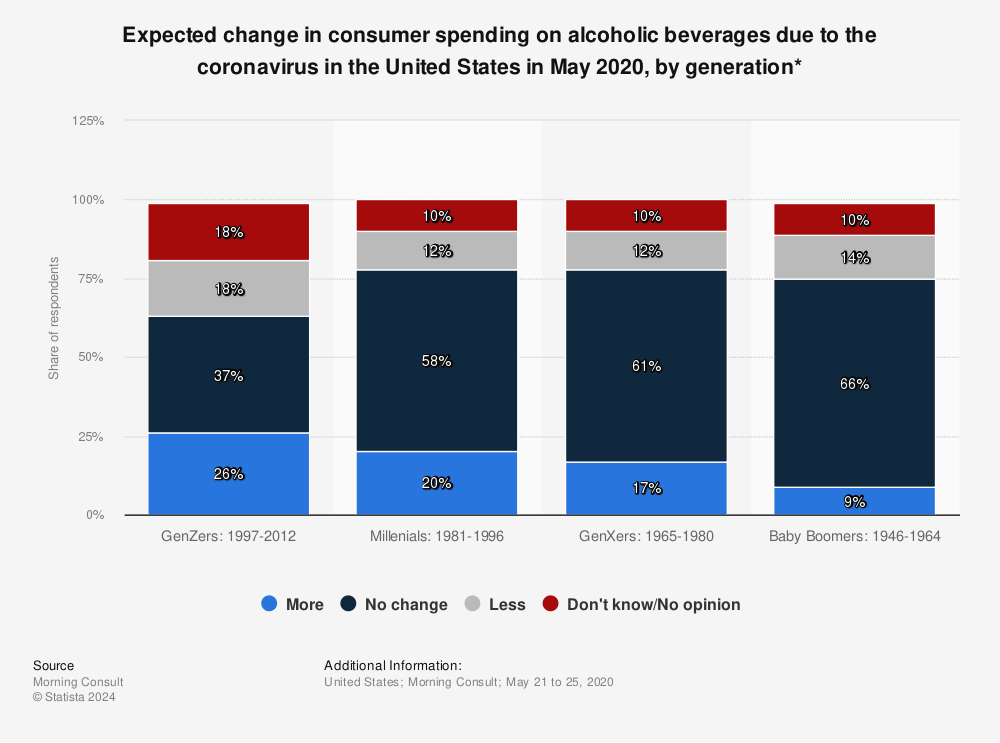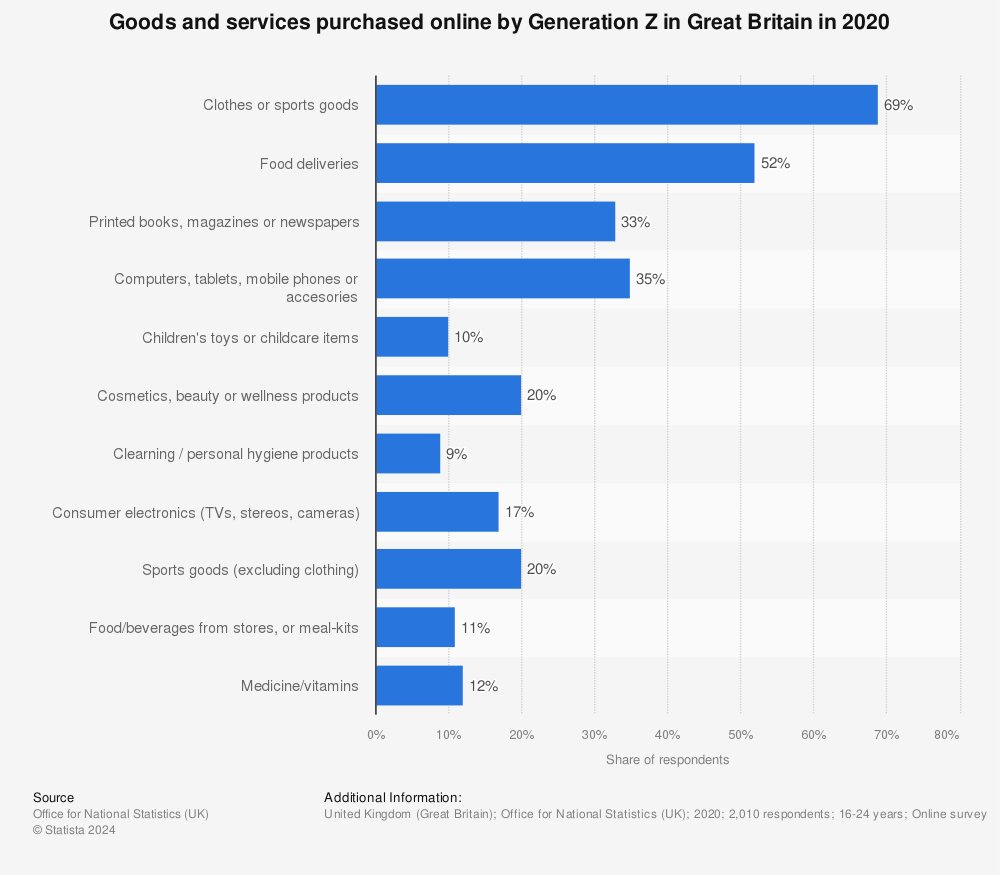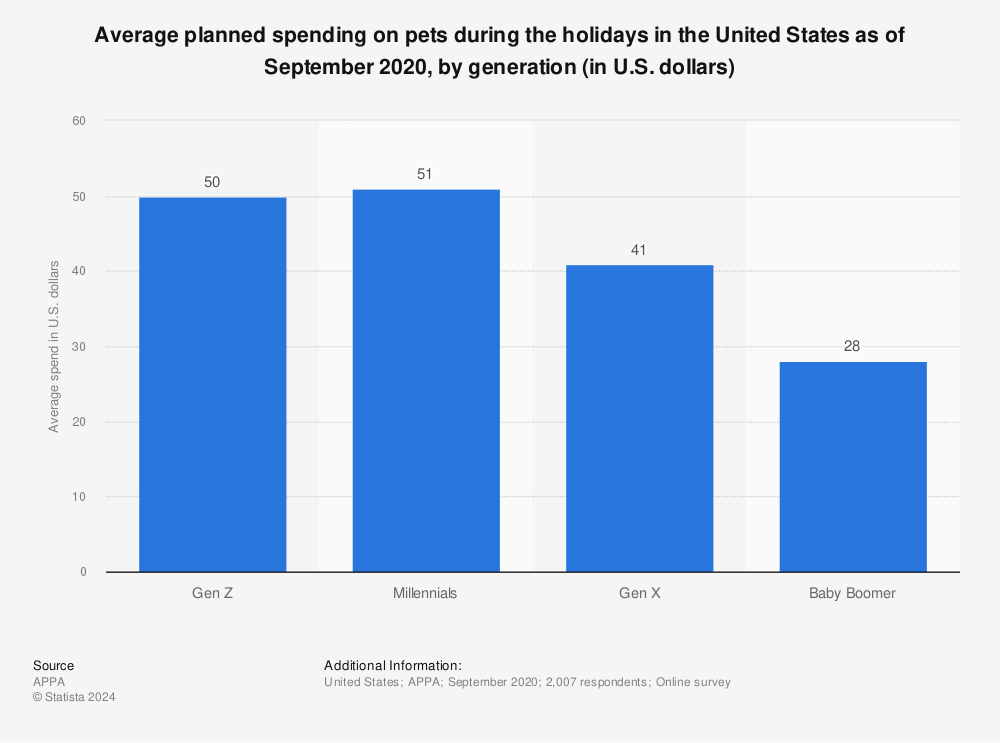25 Mind Blowing Stats on Gen Z Spending Habits
While a big chunk of Generation Z is still too young to be employed and spend their own hard-earned money, they still have a huge impact on the buying decisions of their households. As a matter of fact, Forbes reported that 93% of parents admitted that their Gen Zer kids influenced their household spending. That’s …
25 Mind Blowing Stats on Gen Z Spending Habits https://hillbilly.ir/25-mind-blowing-stats-on-gen-z-spending-habits/ https://hillbilly.ir/25-mind-blowing-stats-on-gen-z-spending-habits/#respond مشاور سئو و طراحي سايت Fri, 19 Nov 2021 06:03:54 0000 طراحي و سئو وب سايت https://hillbilly.ir/?p=18201
25 Mind Blowing Stats on Gen Z Spending Habits
While a big chunk of Generation Z is still too young to be employed and spend their own hard-earned money, they still have a huge impact on the buying decisions of their households. As a matter of fact, Forbes reported that 93% of parents admitted that their Gen Zer kids influenced their household spending. That’s …
25 Mind Blowing Stats on Gen Z Spending Habits
25 Mind Blowing Stats on Gen Z Spending Habits
اين پست از سايت باشگاه مشتريان خبري اينفوجاب كه از دانشنامه ويكي پديا مطلبي در مورد "25 Mind Blowing Stats on Gen Z Spending Habits" ارائه شده است، در صورتي كه محتواي اين پست مورد توجه تان واقع شده است، مي توانيد براي مشاهده مطالب بيشتر در زمينه اموزش سئو و ديجيتال ماركتينگ به دسته بندي " "مراجعه كنيد..post-categories{display:inline; list-style: none;} .post-categories li{display:inline;margin-right:0} .entry-content.entry ul{padding-right:0!important;margin-right:0!important}
While a big chunk of Generation Z is still too young to be employed and spend their own hard-earned money, they still have a huge impact on the buying decisions of their households. As a matter of fact, Forbes reported that 93% of parents admitted that their Gen Zer kids influenced their household spending. That’s just one statistic and not even the most interesting one.
Considering the power they already sway, marketing teams have devoted a lot of time to get to know this younger generation better and identify the fundamental differences across generations. We’ve scoured the web and summed up some of the most interesting Gen Z statistics in this blog post.
25 Statistics on Gen Z Spending Habits:
1. Generation Z Make Up Just Over 20% of the US Population
First things first, Generation Z refers to the age group born between 1997 and 2012. According to data shared by Statista, in 2020, there were 67.06 million Gen Zers in the United States and they accounted for 20.35% of the US population.
As of 2020, it was the third biggest generational group, just after millennials (21.93%) and the baby boomers (21.45%). What’s more, compared to other groups, they’re also the most ethnically and racially diverse.
2. They Have a Spending Power of $140 Billion


According to Business Insider, they have a spending power of more than $140 billion. What’s more, it was predicted that they would make up approximately 40% of global consumers in 2020.
3. In 2020, 25% Started Financial Planning
The COVID-19 pandemic forced most of us to re-evaluate our priorities. As a result, in 2020, about 25% of Gen Zers in the US started financial planning for the first time.
4. Half Freelance
While many Generation Zers are still too young to be formally employed, a survey completed in 2020 revealed that 50% of the Gen Zers between the ages of 18 and 22 that participated in the study worked on a freelance basis. It was the highest across all generational groups. To put this in perspective, only 44% of millennials freelance, while only about a third of Generation Xers freelance.
5. They’re Expected to Spend Just Over $1,000 During the Festive Period
According to online data shared by Statista, in 2021, Generation Z is planning to spend $1,154 US dollars during the festive season in the US. It might be lower than the other generations, but it’s still a sizable amount considering that many are only in their teens.
6. It’s Not All About Online Shopping
Surprisingly, Generation Z is shifting more toward brick-and-mortar stores, for clothing specifically, than the millennial generation. From Instagram to department stores to pop-up shops to convenience store chains to specialty stores, they actually shop via multiple formats, a podcast episode of the McKinsey Podcast revealed. Gen Zers will often browse online, but go to the store to purchase the products as they want to enjoy the in-person customer experience too.
A survey completed in 2021 found similar results. Gen Z (and millennials) shopped about equal amounts online and offline each week. So, if your target audience is Gen Z, it’s key that you promote across multiple channels and not concentrate solely on online shopping.
7. Social Media Has a Powerful Impact
While Generation Z is more inclined than millennials to shop in brick-and-mortar stores, one thing that they have in common is that social media is still a powerful medium. A survey revealed that more or less 80% of Gen Z and millennial shoppers have bought a product that they’ve seen in their social media feed. What’s more, about 54% of Gen Z shoppers in the US feel that social platforms are better for finding out about new products than online searches, while 50% of global Gen Z buyers feel this is the case. All in all, they were more likely to buy apparel, beauty and make-up products because of brands’ posts or influencers’ content on social media.
In fact, a survey revealed that in the UK specifically, Gen Zers were more than twice as likely to purchase an item because of influencer marketing. Also, advertising doesn’t bother them as much as other generations as long as they’re getting something free in return.
As of 2020, Snap******** was the most popular social media platform among them, followed by TikTok. YouTube was in third spot.
8. They Spent Less on Amazon in 2020
In 2020, Generation Z was the only group that spent less money on Amazon during Cyber Weekend. While it was only marginal (a decrease of 2.5%), all the other generations increased their spend on the platform in 2020.
With regards to the impact of Amazon Prime delivery services on their shopping habits, a survey completed in 2020 found that 55% of Gen Z shoppers were more inclined to buy more (in other words, increase the total of their order) if that meant that they would get same-day delivery. On the other hand, only 46% indicated that they would have increased their total order if it applied to one-day delivery.
Yet, Amazon remained the most-used eCommerce retail website. About 75% of Generation Z preferred Amazon over other sites like eBay and Walmart.
9. Almost 6% Follow a Vegetarian Diet
As of 2020, about 5.9% of Generation Z in the US answered that they followed a vegetarian diet. About half of that (2.9%) followed a gluten-free diet.
With regards to cuisine favorites, in one study about 48% of men and 51% of women stated that they preferred Mexican food.
Bo Finneman, a McKinsey associate partner, explains that among the Gen Zers there’s a boom in niche diets. A lot of this can be attributed to the generation’s desire to know the story behind the supply chain of food (similarly to how they want to know what makes the brands that they choose to support tick). Also, because the story behind their food is so important to them, about 35% of Gen Zers state that they’re not buying their food from so-called traditional grocery stores.
10. Homemade Food Is Not High on Their List
While Generation Z cares about what they eat, one study found that preparing food at home is not one of their habits. As of 2020, only about 17% indicated that they prepared homemade food every day, while slightly more than double that (37%) said that they prepared homemade food at least a couple of times per week. Also, only 15% expected to spend more on meal-kit delivery services in 2020.
What’s more, in 2020, about 13% of Gen Zers confessed that they ate drive-thru food more often because of the pandemic. On the other hand, 36% stated that they dined out less often.
With regards to their plans for after the pandemic, 44% revealed in the Deloitte Global 2021 Millennials and Gen Z Survey that they’ll eat out more often at restaurants.
The key takeaway – this generation values going out and enjoying experiences over being “stuck” at home.
11. Almost a Third Spend More on Alcoholic Beverages and Grocery Delivery Services in 2020
Make no mistake, 2020 was a tough year. Yet, only 26% of Gen Zers in the US spent more on alcoholic beverages last year. That being said, it was the highest increase among the different generational groups.
With regards to grocery shopping, 32% expected to pay more for grocery delivery services in 2020. Only 12% expected to pay less.
12. Recreational Marijuana Use Is on the Increase
In the US, Gen Zers accounted for the highest year-on-year sales growth of recreational marijuana between 2019 and 2020. Sales grew by about 127%!
While recreational cannabis use was high among this generation, they were far less likely than millennials to give their pets CBD products, according to a survey completed in Q1 2021.
13. Almost 25% Have At Least One Tattoo
Recent surveys completed in the US revealed that 23% of Gen Z had one or more tattoos as of 2021. Of this 23%, 4% had only one while 19% had multiple tattoos. To put this in perspective, 41% of millennials had at least one tattoo, while 32% of Generation X had one or more.
14. Clothing or Sporting Goods Are the Most Purchased in the UK
In Great Britain, clothing or sports goods were the most popular online purchases in 2020. Nearly 70% of Gen Zers bought items in this category.
In second spot, it was food deliveries with just over half of Gen Z placing food deliveries online. Computers, tablets, mobile phones or accessories were in distant third position.
Other popular goods and services included:
- Printed books, magazines, or newspapers
- غير مجاز مي باشدmetics, beauty, or wellness products
- Consumer electronics
15. Their Favorite Genre Is Music Videos
In 2020, music and music videos were what Gen Z watched the most. More than 60% stated that they watched this genre. About 32% watched reality TV and animal content.
16. Netflix the Most Popular Among Gen Z
As of August 2021, Generation Z was the most likely to have a Netflix subscription in the US. Nearly 80% stated that they subscribed to Netflix. To put this in perspective, only 49% of baby boomers were subscribers.
17. Nearly 40% Enjoy Board Games
Perhaps surprisingly, a survey completed in 2020 found that in the US younger generations enjoyed board games more than older generations. As of May 2020, 38% of Gen Z participants stated that they really enjoyed playing board games. However, it didn’t apply to card games. Only 26% of Gen Zers enjoyed playing a game of cards.
18. Nike Is Their Favorite Brand
In a study completed in 2021 about favorite brands, products, and services, about 20% of Generation Z indicated that Nike was their overall favorite. In second spot it was Apple (15%), while Amazon was in third place (9%).
Nike, Apple, and Amazon were also the top three favorite brands for millennials. Though, Apple and Amazon were favored above Nike by this generation group.
Other brands that are loved by Gen Zers are Vans, Gucci, and Adidas. According to Interbrand, 60% of Gucci’s sales were coming from this generation.
19. They Hold Brands to a Higher Standard


In a conversation between McKinsey and their partners about the role Gen Z and millennials play on the future of shopping, one point that was highlighted is the shift in values. Bo Finneman commented that authenticity is really important to them. If a brand is in some way inauthentic, these youngsters will expose them.
In short, they want to change corporate responsibility. To them, it’s more important to know what the company is all about than to know about the actual products. Gen Zers want to know about the mission and goals for the company.
There’s a much bigger emphasis on sustainability and value. At the end of the day, they really analyze their spending habits. For example, the Deloitte Global 2021 Millennials and Gen Z Survey found that over 25% of Gen Zers admitted that the impact on the environment caused by certain businesses has affected their buying decisions. Another study also revealed that as of 2021, 79% of Gen Zers were willing to pay more for clean energy.
A key takeaway is that if your target audience is Gen Zers, it’s better to work with a network of micro-influencers than one big influencer as micro-influencers are typically seen as more authentic. Also, Bo Finneman explains that this generation has the ability to filter social media. So, while they’re comfortable listening to the opinion of influencers, their family and friends’ opinions still have weight too.
20. They’re Willing to Spend on Luxury
According to Emma Spagnuolo, a management consultant with McKinsey & Company, Gen Zers are willing to spend on luxury. However, their view of luxury differs from the more traditional view. To them, luxury is about being unique – an item that will set them apart – and not necessarily merely a brand name. In short, unlike millennials, luxury for them is more about being unique than exclusive.
Though, in 2020, almost half confessed that they bought store brands to save money. Less than 20% said that during the COVID-19 pandemic they felt no need to increase the number of store brand items that they bought.
21. The Majority Use Reward Apps
While Gen Z don’t mind spending on luxury, online data reveals that as of June 2020, about 70% of the generation in the US often used in-store shopping reward and savings apps. Also, just over 50% indicated that they regularly used deal comparison apps.
22. The Majority Have Used BNPL
A survey completed in 2021 revealed that about two thirds of Gen Zers in Australia have used buy now pay later (BNPL) in the past six months.
In the US, the picture is slightly different. Only about 37% of Gen Z digital buyers were expected to use this payment method in 2021. Yet, in the US, they’re still leading the way and only about 30% of millennials and Gen X are open to embracing this payment method.
23. More Than 50% Have Donated to Charities


Generation Z doesn’t care just about enjoying rewards for themselves, but also about the welfare of others. According to the Deloitte Global 2021 Millennials and Gen Z Survey, 52% have donated to charities in the past two years. Other popular ways that they’ve taken action to drive the change they want to see in the world include raising money for charity by sponsorship (36%) and by means of volunteering (40%).
24. Over 15% Got a New Pet in 2020
A survey completed in September 2020 found that more or less 16% of Generation Z participants got a new pet because of the COVID-19 pandemic. To put this in perspective, only 3% of baby boomers welcomed a new furry friend.
With regards to their spending habits, another survey completed in the same period revealed that Generation Z planned to spend about $50 on average on their pets during the holiday. Only millennials planned to spend more on their pets and that was by only a dollar. In fact, 60% of Gen Z participants in another study revealed that they planned to buy their pet a gift this holiday season.
On the other hand, a survey completed a year later in August 2021, revealed that overall Generation Z pet owners spent the most. Millennials came in second.
25. Almost 20% Recycle Electronic Waste
As mentioned, sustainability is crucial to this generation. So, it doesn’t really come as a surprise that they’re the second-most likely to recycle electronic waste. According to Statista, 17.6% recycled their electronic waste in 2020.


26. About 21% Plan to Buy a Home Before June 2022
A survey completed among more than 13,000 US participants revealed that more or less 21% of the Gen Z generation had plans to buy a home before June 2022. To put this in perspective, in Q3 2019 only about 11% indicated that they were planning to purchase a home. Also, as of Q2 2021, the average for all adults who had such aspirations was only 17%. So, compared to other adults, Gen Z is more keen to enter the housing market soon.
On the other hand, another survey completed in September 2020, revealed that 7% of Gen Z don’t plan to own a home ever.
The main reason for wanting to buy a home was to have a place for their family to grow in. Other reasons included to acquire more space (19%), to gain outdoor space (9%), and to save money on payments (17%).







 انتظار مي رود شركت هاي بزرگي كه از DRaaS استفاده مي كنند در طول دوره پيش بيني بر بازار DRaaS تسلط داشته باشند.
انتظار مي رود شركت هاي بزرگي كه از DRaaS استفاده مي كنند در طول دوره پيش بيني بر بازار DRaaS تسلط داشته باشند.